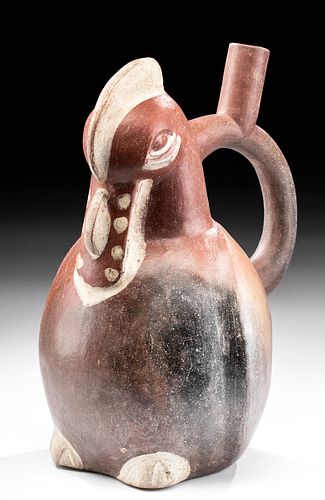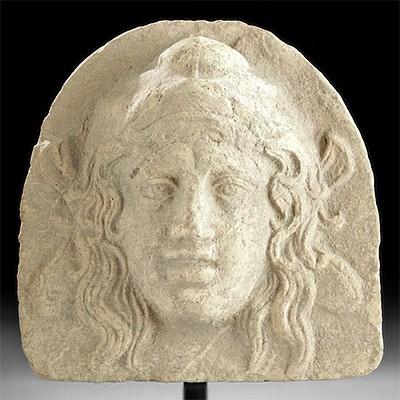Moche Bichrome Pelican Stirrup Vessel
Lot 134
About Seller
Artemis Fine Arts
686 S Taylor Ave, Ste 106
Louisville, CO 80027
United States
Selling antiquities, ancient and ethnographic art online since 1993, Artemis Gallery specializes in Classical Antiquities (Egyptian, Greek, Roman, Near Eastern), Asian, Pre-Columbian, African / Tribal / Oceanographic art. Our extensive inventory includes pottery, stone, metal, wood, glass and textil...Read more
Estimate:
$2,000 - $3,000
Absentee vs Live bid
Two ways to bid:
- Leave a max absentee bid and the platform will bid on your behalf up to your maximum bid during the live auction.
- Bid live during the auction and your bids will be submitted real-time to the auctioneer.
Bid Increments
| Price | Bid Increment |
|---|---|
| $0 | $25 |
| $300 | $50 |
| $1,000 | $100 |
| $2,000 | $250 |
| $5,000 | $500 |
| $10,000 | $1,000 |
| $20,000 | $2,500 |
| $50,000 | $5,000 |
| $100,000 | $10,000 |
| $200,000 | $20,000 |
About Auction
By Artemis Fine Arts
Feb 27, 2020
Set Reminder
2020-02-27 10:00:00
2020-02-27 10:00:00
America/New_York
Bidsquare
Bidsquare : VARIETY SALE | Antiquities & Ethnographic Art
https://www.bidsquare.com/auctions/artemis-gallery/variety-sale-antiquities-ethnographic-art-4920
Around the world & back in time - be amazed at the treasures you will find. Antiquities from Egypt, Greece, Italy and the Near East, Asian, Pre-Columbian, African / Tribal / Oceanic, Native American, Spanish Colonial, Russian Icons, Fine Art, much more! Artemis Fine Arts info@artemisfinearts.com
Around the world & back in time - be amazed at the treasures you will find. Antiquities from Egypt, Greece, Italy and the Near East, Asian, Pre-Columbian, African / Tribal / Oceanic, Native American, Spanish Colonial, Russian Icons, Fine Art, much more! Artemis Fine Arts info@artemisfinearts.com
- Lot Description
Pre-Columbian, Moche IV, North Coast Peru, ca. 400 to 500 CE. A lovely bichrome Moche pottery stirrup vessel, with the details painted in a creamy white pigment over an earthy red background. The bird sits with its long-beaked head against its chest, as if resting. The stirrup handle and spout rises from its upper back. A long, narrow crest is atop the bird's head, which also has large eyes and a beak with cream-hued dots painted along its edges; its tiny feet are also painted white. Size: 5.5" W x 9" H (14 cm x 22.9 cm)
In ancient Peru, pelicans were admired for their adept skills, their wide wingspan, and their graceful flight; not to mention their ability to fly low just above the water to scoop a heap of fish in their large beaks and then drain the water though their bill which acts as a sieve. As inhabitants of the offshore Guano Islands, pelicans are among the rare producers of guano, a substance that was used as fertilizer by the Moche and later the Incas. To this day one can still see flocks of hundreds of pelicans nesting on these islands, a sight to behold both in ancient and modern times. The Moche and other ancient Peruvians believed that pelicans had the ability to dive into the world of the ancestors.
A similar example is published in "The Spirit of Ancient Peru: Treasures from the Museo Arqueologico Rafael Larco Herrera" (New York: Thames and Hudson, 1997, p. 107).
Provenance: ex-private Hans Juergen Westermann collection, Germany, collected from the 1950s to the 1960s
All items legal to buy/sell under U.S. Statute covering cultural patrimony Code 2600, CHAPTER 14, and are guaranteed to be as described or your money back.
A Certificate of Authenticity will accompany all winning bids.
We ship worldwide and handle all shipping in-house for your convenience.
#101398Intact, in wonderful condition for its age, with a few tiny chips and nicks. Light deposits on surface and great preservation of pigment. Nice firing mark on chest.Condition
- Shipping Info
-
All shipping is handled in-house for your convenience. Your invoice from Artemis Gallery will include shipping calculation instructions. If in doubt, please inquire BEFORE bidding for estimated shipping costs for individual items.
-
- Buyer's Premium



 EUR
EUR CAD
CAD AUD
AUD GBP
GBP MXN
MXN HKD
HKD CNY
CNY MYR
MYR SEK
SEK SGD
SGD CHF
CHF THB
THB















